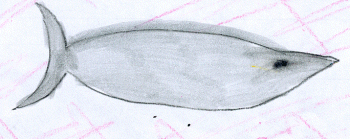
|
|

Bioluminscence is the ability of living things to give off a glow or a light. Light comes from the tissue of the animal and is made by chemicles mixing inside their bodies - but the light does not give off heat. Most, though not all of these animals live in the sea and the colours can be red, orange, yellow, green, blue or violet - the colour of biolumiscence most often found in the sea is blue. Though sardines do not give off light themselves - as they move, they disturb tiny organisms which produce light. Indeed, in some parts of the sea, bioluminescent creatures are so abundant, that any disturbances can produce a shimmering light shadow. Therefore, sardine fishing is done on dark nights with no moon.
 The organs of the Lantern Fish
The organs of the Lantern Fish
Bioluminscence has the overall effect of allowing the sea to almost glow! When waves crash against the shore, bands of luminescence - like the neon tubes of fleurescent lights - light up spectactularly. During the war, undercover work in darkness was made much more difficult when on the sea and there was bioluminescence in the area!
The following animals also glow: Decapod shrimp, Bristle mouth Fish, Krill, and Gelatinous Zooplankton.
![]()
 Photosynthesis is a food-making process in plants. The word means "putting together with light".
Photosynthesis is a food-making process in plants. The word means "putting together with light".
The main function of leaves is to make food for the plant through a process called photosynthesis. Leaves are really like small factories - different parts of the leaf having a different job.
Green plants use energy from the sun to mix water and carbon dioxide to make sugar and other chemicals. Leaves are green because they contain small bodies called chloroplasts and these chloroplasts contain a pigment called chlorophyll. This green material gives the leaf its colour. When all the light and minerals and carbon dioxide has been absorbed, it can be made into starch, fat, vitamins and sugars that the plant needs to live. The food that we eat comes from this sugar.
The sugar is mixed with water and sent to other parts of the plant as food. Oxygen is released into the air through stomata - small holes in the underside of the leaves.